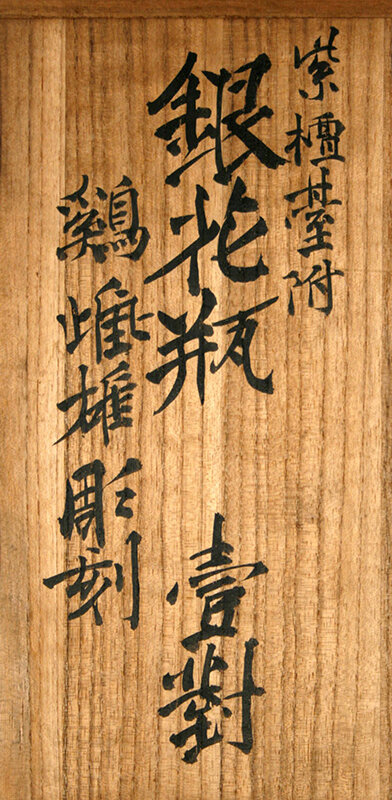MEIJI-TAISHO
HIRAYAMA KANTEI, PAIR OF SILVER VASES WITH BANTAM COCKERELS
Pair of vases in baluster form, decorated in high relief with a design of a pair of Bantam chickens. The vases of hammered silver, with fitted interior otoshi or water containers, the birds executed in exceptionally high-relief taka-zogan of carved and inlaid shakudo, shibuichi, silver and two colors of gold, the back of the right-hand vase with a flowering plant inlaid in carved shibuichi and gold, and the back of the left-hand vase with bamboo inlaid in shakudo and shibuichi. Each vase signed on the back with an inlaid, carved gold, oval seal-form signature by the artist: Kantei (Hirayama Kantei, active in Tokyo during the early 20th century). Each signed on the reverse by the artist who hammered the vases with a chiseled and gilt signature: Mitsuyuki, and with a kao or stylized art signature; and each stamped on the reverse: Jun Gin Sei or Made of Pure Silver. With the original, carved rosewood stands. Late Meiji – Taisho era, circa 1900 – 1916.
With the original, period storage box, inscribed on the exterior of the lid: Niwatori Shiyu Chokoku, Gin Kabin Ittsui, Shitan Dai Tsuki or A Pair of Silver Vases, (With) a Sculpted Male and Female Pair of Bantam Chickens, With Rosewood Stands.
By repute, these vases came out of one of the Arisugawa mansions in Tokyo. A princely house dating back to 1672, the family enjoyed renewed prominence during the Meiji and Taisho eras. Prince Taruhito (1835 – 1895) was prominent during the Meiji Restoration, commanding the army sent to subdue the shogunate and the suppression of the Satsuma rebellion. In 1889, he was appointed chief of the general staff of the army. His half-brother, Prince Takehito (1862 – 1913), married Maeda Yasuko, the daughter of Maeda Yoshiyasu (former daimyo of Kaga), and became an admiral in the Japanese navy. They were major patrons of the arts, and of the Kyoto metal artist, Chikueido Eishin I.
For another example of this artist’s work, c.f. The Nasser D. Khalili Collection of Japanese Art: Meiji No Takara: Treasures of Imperial Japan, Metalwork Part II, number 138. The Khalili incense burner is in the form of a silver elephant, richly caparisoned and supporting a crystal ball.
These Hirayama Kantei vases represent the finest metal carving and inlay work from Japan’s Imperial Golden Age. Kantei works in very deep relief. Gold, silver, shakudo and shibuichi lavishly color the surface. As if inspired by the naturalism of Nihonga painting, fine chiseling textures the inlays like a painter’s brush. To support the deep relief inlays and provide an appropriate canvas for his work, Kantei ordered from the hammering artist, Mitsuyuki, silver vases of extraordinary weight.
The Bantams puff out their beautiful, rich plumage. A few feathers fall about them as the male leaps and his mate dances below. Flowers bloom in the background and bamboo waves in the summer breeze.
Hirayama Kantei, Pair of Silver Vases with Bantam Cockerels
Artist Name: Hirayama Kantei
Period: Meiji Taisho
Mediums: Metalwork
Form: Vase
Origin Country: Japan
12” high x 5 ½” diameter, dimensions of each vase alone
This piece is no longer available.







